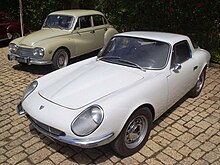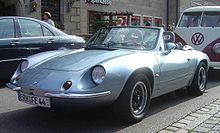Puma (car brand)
Puma was a Brazilian car brand. The vehicles were originally built on the DKW-Vemag basis , but after the demise of this brand they switched to technology from Volkswagen do Brasil and in their final phase were made from components from General Motors . There were around 20 different models, all of which were based on a central tubular frame with a GRP body in their basic construction .
In 1979, the most successful year of production, 3595 Pumas (GM-based) were created. A total of around 22,000 vehicles were built. In 1995 Ford acquired the rights to the Puma brand and used the name from 1997 to 2002 for the Ford Puma .
Creation of the brand
In the 1950s and 1960s, Brazil tried hard to catch up with the western industrialized nations. A visible expression of this was, in addition to the construction of the then ultra-modern capital Brasília , the development of a national automotive industry. In order to achieve this goal, partnerships were entered into with major automobile manufacturers, including Volkswagen. At the same time, high import duties were levied on finished automobiles to promote domestic production facilities . On the one hand, this led to companies such as Volkswagen or General Motors expanding their production capacities in Brazil, but at the same time only the usual "bread and butter cars" were in the program. Elegant, mostly two-seater sports cars, which were very much in vogue at the time, hardly came onto the Brazilian market.
The amateur racing driver and lawyer Genaro (Rino) Malzoni from Matão ( São Paulo ) began to build his own competition car at Automóveis Lumimari in 1964 for use on the racetrack . The basis was the technology of the "DKW 3 = 6" with a two-stroke engine and the DKW-typical front-wheel drive . After three prototypes, the final shape for the GT Malzoni was found. In 1967 the successor model, the "DKW Puma GT", from the new company Puma Veículos e Motores Ltda appeared. from São Paulo . The vehicle consisted of a central tubular frame and a GRP body, a design that has become increasingly popular, especially among small -scale manufacturers, since the introduction of the Corvette from Chevrolet (1953). Thanks to strong demand, the originally planned homologation series developed into a small series production in the second year of production . 121 sports cars produced in 1967 were a first high point. Another source names 135 vehicles based on DKW for 1967.
However, 1967 also brought a fundamental change in the technical design: the DKW brand experienced a long decline. At first the brand was still in the hands of Daimler-Benz and was sold to Volkswagen in 1964 . After that there were no more technical developments at DKW. In 1968 DKW production in Brazil was stopped. For the company's founder, Rino Malzoni, it made sense to start negotiations with the new owner of DKW. Under slight pressure from the government, an agreement was reached with Volkswagen.
VW-based Puma
At first glance, this decision gave the young Puma brand clearer sports car attributes: The most important change was the change from DKW-typical front- wheel drive to sporty rear-wheel drive . On the engine side, a four-cylinder four - stroke engine was used instead of the previous (but not unsporting) three - cylinder two-stroke engine from DKW. The basis was initially provided by the VW Karmann Ghia , which was also available in Brazil. After production of the Karmann Ghia was discontinued in 1974, Volkswagen do Brasil delivered floor assemblies for the VW Brasília to São Paulo.
The VW Puma GT was initially delivered with a 1.5 liter engine. In the course of 1970 the Puma got the boxer engine with 1600 cc displacement. A Puma GT 1800S was also available for a short time.
In 1969 a 2 + 2-seater coupé was created under the type designation GT 4R. The Puma GT 4R was officially built in a total of three units and raffled off to participants in a competition run by the car magazine Quatro Rodas (German: four wheels ). A coupé was built for the company's founder Rino Malzoni. Another copy went to an unknown person. The prototype of these vehicles was made of metal and reappeared in 2011. Between 1971 and 1972 the Puma GT Spider was the first convertible in the range of the car manufacturer from Brazil. From 1973 to 1975 the convertible of the second series was sold under the name Puma GTS. 1975 came out the convertible of the second series in variant B. From this point on, both the convertible and the coupé were built on the basis of the VW Brasília, which is only available in Brazil.
The export activities that began in 1970 provided a significant boost to production figures. Several Puma GTE (the E stands for “export”) came as so-called kitcars to the USA , and as finished vehicles to Canada , Europe and Central America. A few vehicles also reached Australia (1979) and the Japanese market (1981). Worldwide, however, pumas remained exotic. The vehicles exported to the USA had to be delivered in parts due to US import regulations: the body, axles, engine and wheels were only allowed to be imported as separate assemblies. Many importers only had the bodies come from Brazil and completed the vehicles with VW or third-party parts from the US market. For a short time, entire cars could be sold to America, until in 1981 new registration regulations meant that Puma vehicles that had already arrived in America had to be sent back to Brazil.
Puma with GM technology

In addition to the Volkswagen series, the development of a second model series began as early as 1970. At that time, it was decided to establish a second mainstay in cooperation with General Motors based on the Chevrolet Opala model with a four or six-cylinder engine (2.5 or 4.1 liter displacement). The design of the Puma GTO (Gran Turismo Omologato) came from Rino Malzoni and Britinho, a vehicle designer from Ford. The vehicles were delivered from 1973 with a 4.1 liter engine from General Motors. The interior of the GTB models was quite exclusive compared to the other Puma models with leather upholstery, electric windows and air conditioning. In contrast to Volkswagen, GM supplied the engines without an engine number. This made it possible for the chassis number and engine number to be the same for the GM-based Puma models. The GTB was offered between 1973 and 1978.
The second edition of the GTB, called GTB S2, was presented to the public for the first time at the São Paulo Motor Show in 1978. Compared to the GTB, the front of the GTB S2 is flatter. It received double headlights and new taillights and the indicator glasses were integrated in the bumper. When it comes to equipment, the focus is on comfort and the latest technology. This included power steering , air conditioning, lots of leather, and retractable seat belts. The GTB S2 was offered between 1979 and 1984.
Between 1974 and 1980 the carmaker recorded the highest production figures in the entire history of the brand. After that, however, the decline followed. Brazil's economy had lost the race with industrialized nations and fell into a protracted crisis. At the same time, the import regulations were relaxed and opened the market for inexpensive and technically sophisticated sports cars, especially from Japan . Puma Indústria de Veículos SA was unable to withstand this pressure in the long term. The production figures fell within five years from over 3000 units to less than 100 vehicles in 1984. The company was sold. Araucária SA Indústria de Veículos was bought by Niveo de Lima in 1987 and traded as Alfa Metais. Under his direction the AM1 (Coupé) and the AM2 (Convertible) came onto the market. The successor to the Puma GTB was the AMV 4.1. After a facelift in sports cars, the end of this division was sealed in 1993. After that no more cougars were made. In 1995 Ford acquired the trademark rights to the Puma name for Europe. The trademark rights to Puma for the American continent still belong to the de Lima family.
Puma construction data using the example of the GT 1600 (1970)
The Puma GT 1600 was a coupé with a central tubular frame and the floor pan of the VW Karmann Ghia Type 14 shortened by 27 cm . It was powered by the air-cooled 1600 cc four-cylinder boxer engine from Volkswagen. The engine had exactly 1584 cm³ displacement ( bore 85.5 mm, stroke 69 mm) and developed 70 SAE-PS (40 kW / 54 PS) at 4200 rpm. It had overhead valves, a central camshaft , light alloy cylinder heads and cylinder block and a four-bearing crankshaft. It was equipped with a downdraft carburetor alternatively from Solex or Brosol , a Brazilian carburetor manufacturer who used the classic Solex carburetor as a model. The rear-wheel drive sports car had a four-speed fully synchromesh transmission with a hypoid final drive. The central tubular frame was forked at the rear with the platform of the Karmann Ghia as the construction floor. At the front it had double crank arms with transverse torsion bar springs, at the rear independent wheel suspension with a pendulum axle, trailing arms and transverse torsion bar springs. Disc brakes with a diameter of 27.8 cm on the front axle , drum brakes on the rear .
The wheelbase was given as 2150 mm, track 1315/1310 mm, ground clearance 170 mm, length 3960 mm and width 1580 mm, height 1160 mm. The top speed was named 160 km / h, with a power-to-weight ratio of 9.7 kg / PS, the average consumption according to DIN was 7.7 liters per 100 km.
commercial vehicles
Until 1999 the company also manufactured commercial vehicles.
Production numbers
|
|
Another source cites 135 vehicles for 1967. For 1974 the number 1139 is also recorded, and for 1979 3609 vehicles (including 179 trucks ).
literature
- Harald H. Linz, Halwart Schrader : The International Automobile Encyclopedia . United Soft Media Verlag, Munich 2008, ISBN 978-3-8032-9876-8 , chapter Puma (I).
- George Nick Georgano (Editor-in-Chief): The Beaulieu Encyclopedia of the Automobile. Volume 3: P – Z. Fitzroy Dearborn Publishers, Chicago 2001, ISBN 1-57958-293-1 , pp. 1276-1277. (English)
Web links
- João F. Scharinger: Lexicar Brasil (Portuguese, accessed September 24, 2016)
- Internet pages of the Puma friends in Germany
Individual evidence
- ↑ Harald H. Linz, Halwart Schrader : The International Automobile Encyclopedia . United Soft Media Verlag, Munich 2008, ISBN 978-3-8032-9876-8 , chapter Puma (I).
- ↑ Thomas Braun: Puma types and history. 2011, p. 2.
- ^ A b George Nick Georgano (Editor-in-Chief): The Beaulieu Encyclopedia of the Automobile. Fitzroy Dearborn Publishers, Chicago 2001, ISBN 1-57958-293-1 , pp. 1276-1277. (English)
- ↑ Thomas Braun: Puma types and history. 2011, p. 64.
- ↑ a b Thomas Braun: Puma types and history. 2011, p. 109.
- ↑ Thomas Braun: Puma types and history. 2011, p. 60.
- ↑ a b João F. Scharinger: Lexicar Brasil (Portuguese, accessed September 24, 2016)
- ^ D'Auto (Dutch, accessed September 24, 2016)






